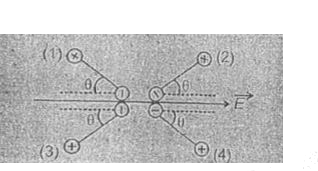Arrangement of electrodes in order of reduction potentials is known as.......
Step-by-Step Solution:
1. Understanding the Question:
The question asks for the term used to describe the arrangement of electrodes based on their reduction potentials.
2. Identifying the Concept:
The arrangement of electrodes in order of their reduction potentials is a fundamental concept in electrochemistry. It helps us understand how different substances behave as oxidizing or reducing agents.
3. Defining the Term:
The term used to describe this arrangement is the Electrochemical Series. This series lists various electrodes according to their standard reduction potentials.
4. Understanding the Electrochemical Series:
- The electrochemical series is arranged in order of increasing reduction potential values.
- The standard hydrogen electrode (SHE) is used as a reference point, assigned a potential of 0 volts.
- Elements above the SHE in the series are stronger oxidizing agents, while those below are stronger reducing agents.
5. Examples of the Electrochemical Series:
- For example, the reduction potential of copper (Cu²⁺ + 2e⁻ → Cu) is approximately +0.80 V, indicating it is a good oxidizing agent.
- Conversely, sodium (Na → Na⁺ + e⁻) has a reduction potential of -2.71 V, indicating it is a strong reducing agent.
6. Conclusion:
Therefore, the answer to the question is that the arrangement of electrodes in order of reduction potentials is known as the Electrochemical Series.
---
The question asks for the term used to describe the arrangement of electrodes based on their reduction potentials.
The arrangement of electrodes in order of their reduction potentials is a fundamental concept in electrochemistry. It helps us understand how different substances behave as oxidizing or reducing agents.
The term used to describe this arrangement is the Electrochemical Series. This series lists various electrodes according to their standard reduction potentials.
- The electrochemical series is arranged in order of increasing reduction potential values.
- The standard hydrogen electrode (SHE) is used as a reference point, assigned a potential of 0 volts.
- Elements above the SHE in the series are stronger oxidizing agents, while those below are stronger reducing agents.
- For example, the reduction potential of copper (Cu²⁺ + 2e⁻ → Cu) is approximately +0.80 V, indicating it is a good oxidizing agent.
- Conversely, sodium (Na → Na⁺ + e⁻) has a reduction potential of -2.71 V, indicating it is a strong reducing agent.
Therefore, the answer to the question is that the arrangement of electrodes in order of reduction potentials is known as the Electrochemical Series.
Topper's Solved these Questions
- ELECTROCHEMISTRYBook:FIITJEEChapter:ELECTROCHEMISTRYExercise:Assignment Problems (Subjective) Level-1 (Numerical Problems)
Explore 8 Videos
- ELECTROCHEMISTRYBook:FIITJEEChapter:ELECTROCHEMISTRYExercise:Assignment Problems (Subjective) Level -II
Explore 15 Videos
- ELECTROCHEMISTRYBook:FIITJEEChapter:ELECTROCHEMISTRYExercise:Assignment Problems (Subjective) Level-1
Explore 7 Videos
- CONCEPT OF ACIDS AND BASESBook:FIITJEEChapter:CONCEPT OF ACIDS AND BASESExercise:SINGLE INTEGER ANSWER TYPE QUESTIONS
Explore 4 Videos
- ELECTROPHILIC AROMATIC SUBSTITUTIONBook:FIITJEEChapter:ELECTROPHILIC AROMATIC SUBSTITUTIONExercise:NUMERICAL BASED QUESTIONS INDICATED BY DIGITAL INTERGER
Explore 1 Video
Similar Questions
Knowledge Check
If the orders of reduction potential is then :
AY will oxidize X onlyBY will oxidize Z onlyCZ will oxidize both X and YDZ will reduce both X and YThe electrode with higher reduction potential is written at
Aectreme leftBextreme rightCin the middleDany whereLi, Ca and K metals can be arranged in the decreasing order of their standard reduction potentials as __________.
ACa , K , LiBLi , Ca , KCK , Ca ,LiDLi , K , Ca
A certain electrode has a standard reduction potential of 0.140V when measure against a saturaed calomel electrode (E∘RP=+0.244V). Calculate its standard reduction potential against a standard H-electrods.
View SolutionThe Nernst equation giving dependence of electrode reduction potential on concentration is
View SolutionA certain electrode has standard ( reduction potential ) of 0.384V. The potential when measured against a normal calomel electrode ( with electrode potential=0.28V) is
View SolutionK,Ca and Li metals may be arranged in the decreasing order of their standard electrode potentials as
View SolutionArrange the following in the order of increasing ionization potential
View Solution
